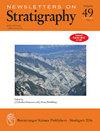中欧盆地与特提斯陆架海西部三叠系—侏罗系过渡层总有机碳-δ13C特征对比研究
IF 2.1
3区 地球科学
Q1 GEOLOGY
引用次数: 13
摘要
通过解决环境剧变和生物反应之间的因果关系,地层学研究是理解导致三叠纪末大灭绝的事件年表的一个组成部分。三叠系-侏罗系(Tr-J)序列的成功对比由于宏观化石的消失而变得复杂,而宏观化石是地层学研究的核心组成部分。这个问题在位于欧洲的多个Tr-J剖面中更加严重,那里所谓的“事件层”——被认为是划分灭绝间隔的——实际上没有化石。另一种地层学方法需要重建碳同位素记录,其中认为碳同位素组成的地层波动可以跟踪全球生物地球化学碳循环的变化。贫碳酸盐剖面的优势促进了以总有机碳(TOC)为基础的碳同位素记录的重建。然而,大块岩石衍生TOC是沉积在海底的有机组分的成岩稳定残余,其来源可能多种多样。在本研究中,我们评估了Bonenburg(中欧盆地)和Kuhjoch (Tr-J全球层型剖面和点)两个站点基于toc的长期碳同位素趋势;西特提斯陆架海)。我们关注事件层的TOC - 13c富集,目的是破译地层波动与其主要驱动因素(外源碳库与有机质来源变化)的关系。通过对几个沉积参数(TOC、总氮(TN)和有机质组成)的系统协方差分析,我们推断TOC组成在海相和陆相有机碳贡献方面可能具有有机质来源变化不大的特征。相比之下,黏土矿物学向贫钾矿物的转变以及事件层中木材碎片的增加表明,在不断变化的大陆风化机制下,陆相有机质来源从未成熟基质转向以“预老化”或“化石有机质”为主的基质。这一结果敦促在解释基于toc的碳同位素记录时,根据全球碳旋回扰动,特别是当与岩性和矿物学变化相一致时,要有所保留。从更积极的方面来看,向正碳同位素值的转变似乎是一个反复出现的特征,可能证明了全球显著的气候控制的风化机制转变。本文章由计算机程序翻译,如有差异,请以英文原文为准。
A comparative study of total organic carbon-δ13C signatures in the Triassic–Jurassic transitional beds of the Central European Basin and western Tethys shelf seas
Stratigraphic studies are an integral component in understanding the chronology of events that led to the end-Triassic mass extinction, by resolving causal relationships between environmental upheavals and biotic response. Successful correlation of Triassic–Jurassic (Tr–J) successions is complicated by the disappearance of macro-fossils that are otherwise central components in stratigraphic studies. This problem is exacerbated in multiple Tr–J sections situated in Europe, where the so-called “Event Beds” – assumed to demarcate the extinction interval – are virtually devoid of fossils. An alternative stratigraphic approach entails the reconstruction of carbon isotope records, where stratigraphic fluctuations in carbon isotope composition are considered to track changes in the global biogeochemical carbon cycle. The predominance of carbonate-lean sections has prompted the reconstruction of total organic carbon (TOC)-based carbon isotope records. However, bulk rock derived TOC is the diagenetically stabilized remnant of organic components that accumulated on the sea floor, and which can originate from multiple sources. In this study, we assess long-term TOC-based carbon isotope trends at two sites: Bonenburg (Central European Basin) and Kuhjoch (the Tr–J Global Stratotype Section and Point; western Tethys shelf seas). We focus on the TOC 13C-enrichment of the Event Beds with the aim of deciphering stratigraphic fluctuations in relation to their main driver (the exogenic carbon pool versus organic matter source changes). By studying the systematic co-variance of several sedimentary parameters (TOC, total nitrogen [TN], and the palynomorph composition), we infer that the TOC composition is possibly characterized by insignificant organic matter source changes in terms of the marine and terrestrial organic carbon contributions. By contrast, a clay mineralogical shift to more K-depleted minerals as well as the elevated occurrence of wood fragments in the Event Beds suggest a terrestrial organic matter source shift from immature substrates to substrates predominated by “pre-aged” or “fossil organic matter” under a changing continental weathering regime. This outcome urges for reservations when interpreting TOC-based carbon isotope records in terms of global C-cycle perturbations, especially when coinciding with lithological and mineralogical changes. On a more positive note, the shift towards positive carbon isotope values appears to be a recurring feature, possibly testifying to a globally significant climate-controlled weathering regime shift.
求助全文
通过发布文献求助,成功后即可免费获取论文全文。
去求助
来源期刊

Newsletters on Stratigraphy
地学-地质学
CiteScore
5.50
自引率
4.50%
发文量
22
审稿时长
>12 weeks
期刊介绍:
Newsletters on Stratigraphy is an international, peer-reviewed journal with a focus on stratigraphic issues that are relevant for a broad geoscientific community. Papers published in Newsletters on Stratigraphy use (and ideally integrate) stratigraphic methodologies from a wide field of disciplines, including (but not limited to) biostratigraphy, chronostratigraphy, chemostratigraphy, and magnetostratigraphy.
The results have implications for paleogeographic reconstructions, paleoceanography, paleoclimate, biotic evolution, basin development, or regional and supraregional correlation.
Papers published in Newsletters on Stratigraphy comprise original research articles, background information on ongoing work of e.g., the International Stratigraphic Commission (ICS) and the International Subcommission on Stratigraphic Classification (ISSC), and review articles. There are no page charges for the publication of regular papers.
 求助内容:
求助内容: 应助结果提醒方式:
应助结果提醒方式:


